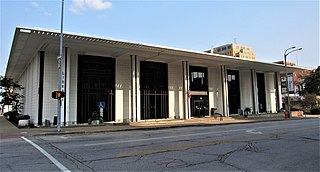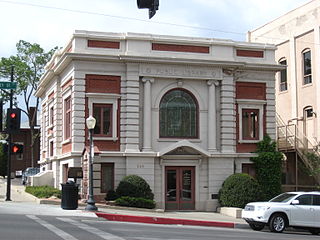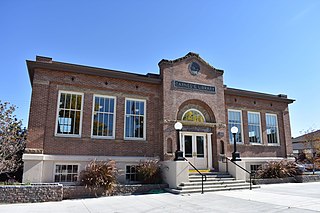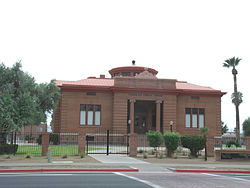
Chandler is a city in Maricopa County, Arizona, United States, and a suburb of the Phoenix, Arizona, Metropolitan Statistical Area (MSA). It is bordered to the north and west by Tempe, to the north by Mesa, to the west by Phoenix, to the south by the Gila River Indian Community, and to the east by Gilbert. As of 2019, the population was estimated at 261,165 according to the United States Census Bureau.

The Seattle Public Library (SPL) is the public library system serving the city of Seattle, Washington. Efforts to start a Seattle library had commenced as early as 1868, with the system eventually being established by the city in 1890. The system currently comprises 27 branches, most of which are named after the neighborhoods in which they are located. The Seattle Public Library also includes Mobile Services and the Central Library, which was designed by Rem Koolhaas and opened in 2004. The Seattle Public Library also founded the Washington Talking Book & Braille Library (WTBBL), which it administered until July 2008.

The Arizona State Capitol in Phoenix, Arizona, United States, was the last home for Arizona's Territorial government, until Arizona became a state in 1912. Initially, all three branches of the new state government occupied the four floors of the statehouse. As the state expanded the branches relocated to adjacent buildings and additions. The 1901 portion of the Capitol is now maintained as the Arizona Capitol Museum with a focus on the history and culture of Arizona. The Arizona State Library which occupied most of the 1938 addition until July 2017 re-opened in late 2018 as a part of the Arizona Capitol Museum.

The Oregon Public Library is located in Oregon, Illinois, United States, the county seat of Ogle County. The building is a public library that was constructed in 1909. Prior to 1909, Oregon's library was housed in different buildings, none of which were designed to house a library. The library was built using a grant from wealthy philanthropist Andrew Carnegie. The grant was obtained after Oregon's citizens voted to change Oregon's library from a city library to a township library. The building was completed by 1908 but the library did not begin operation until 1909.

Illinois Carnegie Libraries Multiple Property Submission was a National Register of Historic Places Multiple Property Submission in the U.S. state of Illinois, approved on February 16, 1994. The submission included a group of sixteen Illinois libraries whose construction was funded by early 20th century philanthropist Andrew Carnegie. The sixteen libraries were all added to the National Register of Historic Places between 1978 and 2002.

The Ludington Public Library is one of the two branches of the Mason County District Library administrative system. This library, as the main branch, is located in downtown Ludington, in Mason County in the Lower Peninsula of Michigan. The library started as an idea that in 1872 formed an association. A trial for a free reading room was undertaken and later a small building was acquired for a definitive reading room.

The Carnegie Art Museum is a public art museum owned by the City of Oxnard, California in the building originally occupied by the Oxnard Public Library. The Neo-Classical building, located adjacent to Oxnard's Plaza Park, opened in 1907 as the Oxnard Public Library and was converted into an art museum in 1986. In July 1971, it became the first building in Ventura County and the first Carnegie library in California to be listed on the National Register of Historic Places.

The Davenport Public Library is a public library located in Davenport, Iowa. With a history dating back to 1839, the Davenport Public Library's Main Library is currently housed in a 1960s building designed by Kennedy Center architect Edward Durell Stone. The Davenport Public Library system is made up of three libraries—the Main Library at 321 Main Street; the Fairmount Branch Library at 3000 N. Fairmount Street; and the Eastern Avenue Branch Library at 6000 Eastern Avenue.

The former Kingston City Library building is located on Broadway in the center of Kingston, New York, United States. It is a brick Carnegie library built in 1903 in the Classical Revival architectural style.

The Old Colorado City Library is a currently operating branch library of the Pikes Peak Library District. It is housed in a 1904 Carnegie Library that has been in continuous service as a library since opening December 7, 1904. The library is located at 2418 West Pikes Peak Avenue, Colorado Springs, Colorado, 80904, in the historic district of Old Colorado City. Current hours of operation, policies, and programming can be found through the Pikes Peak Library District website.

The Greenville Carnegie Library is a historic library on the edge of downtown Greenville, Ohio, United States. A Carnegie library built for the community in the early 20th century, the library and an adjacent school building have been designated a historic site because of their landmark architecture.

The Council Bluffs Public Library serves the residents of Council Bluffs, Iowa, United States along with unincorporated and rural areas of Pottawattamie County. Several cities also contract with the library to provide services. It dates back to 1866. The library is currently located on Willow Avenue. The previous library building on Pearl Street was listed on the National Register of Historic Places in 1999.

Ottumwa Public Library is a public library located in downtown Ottumwa, Iowa, United States. The current building was built in 1901. It is part of the Central Park area, which is the civic center of the community. It includes the Wapello County Courthouse, Ottumwa City Hall, and St. Mary of the Visitation Catholic Church. The library was listed on the National Register of Historic Places in 1984.

Peabody Township Library, also known under the older name of Peabody Township Carnegie Library, was listed on the National Register of Historic Places (NRHP) in 1987. It is located in the Downtown Historic District of Peabody, Kansas, United States.

The Colorado Springs Public Library–Carnegie Building is a Neo-classical library building in Colorado Springs, Colorado. Funded by the Andrew Carnegie Library Fund. The building is on the National Register of Historic Places. It is associated with the City Beautiful movement.

The Carnegie Library at Livermore, California, opened in 1911 and continued in use as a library until 1966. It now hosts a historical museum and art gallery. The building was designed by William H. Weeks in the Greek Revival style and is included on the National Register of Historic Places. A weekly farmers' market takes place in the surrounding park.

The Pittsfield Public Library is located at 110 Library Street in Pittsfield, Maine. The building it occupies is a Beaux Arts building designed by Albert Randolph Ross, and was built in 1903-04 with funding assistance from Andrew Carnegie. The building was listed on the National Register of Historic Places in 1983. It is one of the state's oldest Beaux Arts buildings, and one of the most architecturally distinctive in the town.

The Waterloo Public Library-East Side Branch is a historic building located in Waterloo, Iowa, United States. The public library was established here in 1896. It operated out of two rented rooms, one on the east side of the Cedar River and other on the west side. The Carnegie Foundation offered a grant of $30,000 to build a new library, but disagreements erupted over whether to place the building on the east side or west side of the river. They then agreed to grant $40,000 for a mid-river building, or the same amount for two buildings. In the end they agreed to grant the community $24,000 to build this building and a similar amount for the west side branch. Waterloo architect John G. Ralston designed both buildings in the Neoclassical style. Both were dedicated on February 23, 1906. The single-story Bedford stone structure was built over a raised basement. It is one of the few stone buildings in Waterloo. The building has a central portico with paired Ionic columns. It is part of a larger central mass that is oriented from front to back and sits across the lower hipped roof.

Prescott, Arizona, founded in 1864, soon had a children's library that was a collection of books gathered by several women. A Prescott Library Association opened a public reading room space in 1870. But there was no regularly funded library until the Carnegie library at 125 E. Gurley Street was built in 1903. Its funding and construction was a project of the Monday Literary Society or Monday Club, a group formed in 1895, a group of women dedicated to the educational and cultural well-being of their community. It has also been known as Prescott Public Library and is listed on the National Register of Historic Places under that name. The replacement library, the current Prescott Public Library, built in 1974, is two blocks away.

The Caldwell Carnegie Library in Caldwell, Idaho, also known as the Caldwell Veterans Memorial Hall, was constructed from a grant by the Carnegie library foundation. The building opened in 1914 and was added to the National Register of Historic Places June 18, 1979. Its modest, 1-story Renaissance design is credited to Charles Carroll Soule and features reading rooms on either side of the main entrance. The building also includes a full basement with lecture hall.






















